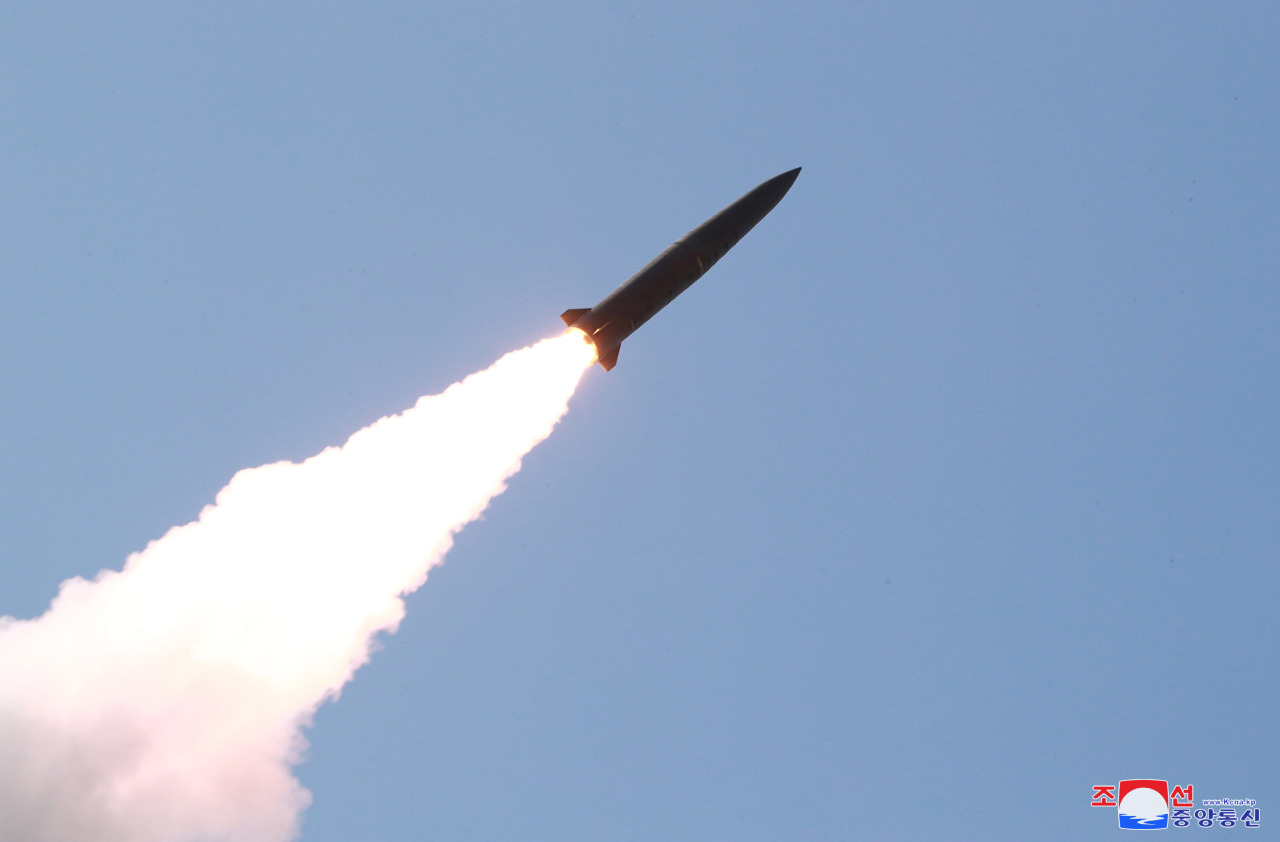As North Korea has fired several short-range projectiles and ballistic missiles on multiple occasions recently, concerns are growing on whether South Koreal’s military would be able to intercept them.
Pyongyang fired two unidentified short-range projectiles on Friday, the third launch to come in eight days. According to Seoul’s Joint Chiefs of Staff, the projectiles, which Cheong Wa Dae says are probably ballistic missiles, flew 220 kilometers into the East Sea at the speed of Mach 6.9 and reached an altitude of about 25 kilometers.
Two days earlier, Pyongyang test-fired what it called “a new type large-caliber multiple launch guided rocket system,” which Seoul and Washington evaluated as two short-range ballistic missiles. On July 25, the regime launched two short-range ballistic missiles, according to the assessment of the intelligence authorities of South Korea and the United States.
While it has not been officially confirmed, some of the short-range missiles are believed to be modified versions of Russia’s Iskander, codenamed KN-23.
Pyongyang fired two unidentified short-range projectiles on Friday, the third launch to come in eight days. According to Seoul’s Joint Chiefs of Staff, the projectiles, which Cheong Wa Dae says are probably ballistic missiles, flew 220 kilometers into the East Sea at the speed of Mach 6.9 and reached an altitude of about 25 kilometers.
Two days earlier, Pyongyang test-fired what it called “a new type large-caliber multiple launch guided rocket system,” which Seoul and Washington evaluated as two short-range ballistic missiles. On July 25, the regime launched two short-range ballistic missiles, according to the assessment of the intelligence authorities of South Korea and the United States.
While it has not been officially confirmed, some of the short-range missiles are believed to be modified versions of Russia’s Iskander, codenamed KN-23.

The authorities believe that projectiles fired on May 4 and 9, and all the launches conducted this year could hit any part of South Korea and US bases stationed here -- 200 km to 690 km.
To ease the growing public fear, government officials here have highlighted the military capability of South Korea, saying that its weapons and operation system is much more superior than that of the North.
“South Korea is far superior to the North in all military operation systems, and we have adequate defense capabilities,” Jeong said at a defense forum Wednesday.
The minister also stressed that the missile technologies the North appeared to be demonstrating were capabilities the South acquired a long time ago.
According to military authorities here, South Korea is prepared with a prominent missile defense system to intercept North Korea’s missiles. Seoul is working to upgrade the current Patriot-2 short-range missiles to PAC-3, that are said to be capable of intercepting the North Korean version of Iskander.
South Korea is also planning to deploy M-SAM II (medium range surface-to-air missile) and is developing L-SAM that would intercept flying missiles in their terminal phases.
Authorities say South Korea also has stronger missile capabilities, both ballistic and cruise types, such as Hyunmoo-2, Haeseong-2 and Taurus.
North Korea is known to have some 800 ballistic missiles, largely aimed for land-to-land strike, and is operating about 100 transporter launchers.
But while all ballistic missiles of South Korea are already developed with solid-fuel engines, the North is in its early stages of building solid-fuel missiles, according to authorities here.
Still, experts caution that it may become more difficult to intercept North Korea’s short-range missiles as they evolve. North Korea also appears to be developing its multiple rocket launchers to be equipped with GPS and guidance capabilities, and a longer range, according to military authorities.
By Jo He-rim (herim@heraldcorp.com)
To ease the growing public fear, government officials here have highlighted the military capability of South Korea, saying that its weapons and operation system is much more superior than that of the North.
“South Korea is far superior to the North in all military operation systems, and we have adequate defense capabilities,” Jeong said at a defense forum Wednesday.
The minister also stressed that the missile technologies the North appeared to be demonstrating were capabilities the South acquired a long time ago.
According to military authorities here, South Korea is prepared with a prominent missile defense system to intercept North Korea’s missiles. Seoul is working to upgrade the current Patriot-2 short-range missiles to PAC-3, that are said to be capable of intercepting the North Korean version of Iskander.
South Korea is also planning to deploy M-SAM II (medium range surface-to-air missile) and is developing L-SAM that would intercept flying missiles in their terminal phases.
Authorities say South Korea also has stronger missile capabilities, both ballistic and cruise types, such as Hyunmoo-2, Haeseong-2 and Taurus.
North Korea is known to have some 800 ballistic missiles, largely aimed for land-to-land strike, and is operating about 100 transporter launchers.
But while all ballistic missiles of South Korea are already developed with solid-fuel engines, the North is in its early stages of building solid-fuel missiles, according to authorities here.
Still, experts caution that it may become more difficult to intercept North Korea’s short-range missiles as they evolve. North Korea also appears to be developing its multiple rocket launchers to be equipped with GPS and guidance capabilities, and a longer range, according to military authorities.
By Jo He-rim (herim@heraldcorp.com)












![[Today’s K-pop] BTS pop-up event to come to Seoul](http://res.heraldm.com/phpwas/restmb_idxmake.php?idx=644&simg=/content/image/2024/04/17/20240417050734_0.jpg&u=)





![[KH Explains] Hyundai's full hybrid edge to pay off amid slow transition to pure EVs](http://res.heraldm.com/phpwas/restmb_idxmake.php?idx=652&simg=/content/image/2024/04/18/20240418050645_0.jpg&u=20240418181020)

![[Today’s K-pop] Zico drops snippet of collaboration with Jennie](http://res.heraldm.com/phpwas/restmb_idxmake.php?idx=642&simg=/content/image/2024/04/18/20240418050702_0.jpg&u=)